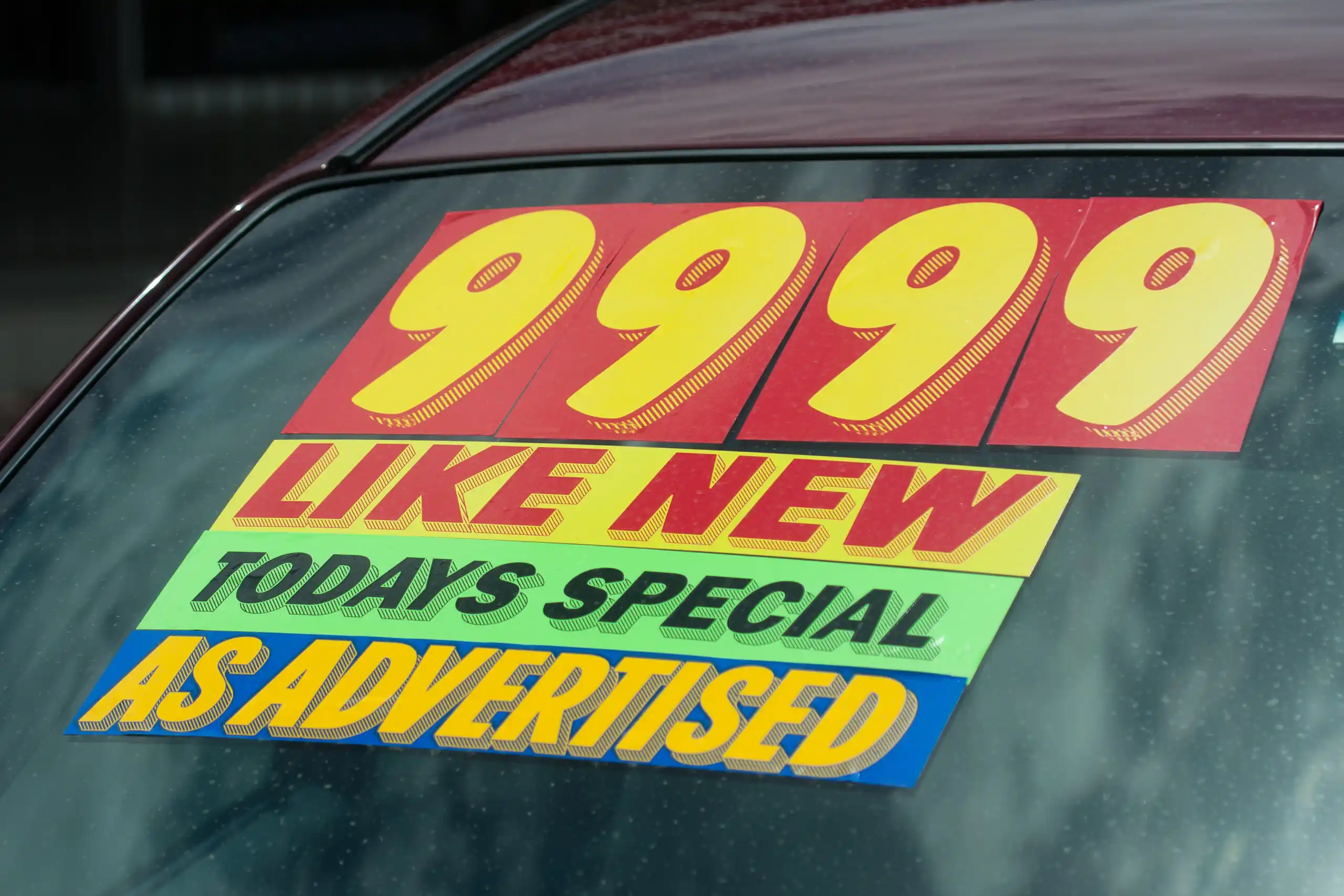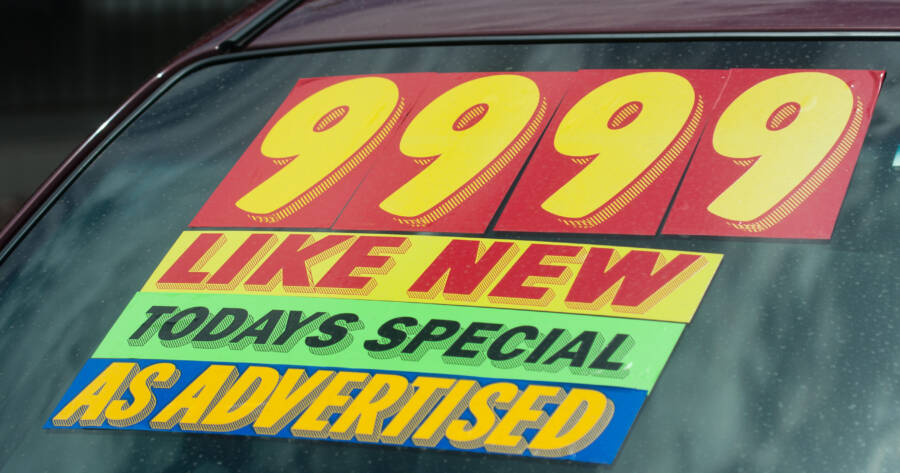My cousin is married to a former automotive engineer and lifelong “car guy.” She jokingly told us it was the reason she married him in the first place. He simply takes all the stress out of car purchases, both new and used. She said that when her husband tells her that a potentially fun or sporty car (that she’s fallen in love with) is no good, she’ll happily walk away. No one wants to be stuck with a lemon, and her husband clearly knows what he’s talking about. But what about the rest of us?
For frugal car shoppers who are not blessed with their own personal mechanical engineer, it can be a minefield. It’s a bit maddening to try to figure out whether a used car is a great deal or a money pit on wheels. The next time you purchase a used car – either from an individual or a dealer – keep these red flags in mind.
Too Many Owners
One of the best things you can do when shopping for a used car is run a Carfax report. It will show you how many owners the car has had (among other things). This is an important factor. If the car has changed hands a number of times, it implies the vehicle may have gone through multiple levels of car and driving styles. While the current owner might insist they took good car of the car, what about the person before them? Or the one before that? If you’re potentially going to be the third, fourth, or fifth owner, you’ll have no idea how the initial owner treated the vehicle.
You should also do some quick math. If the car is only five years old, but has already had four owners, that’s a red flag. Why are these owners so quick to offload their new purchase? It could be an indication that the car has chronic mechanical problems or simple doesn’t live up to expectations in other ways. If multiple previous owners discarded it within a short time frame, you might want to re-think your interest.
Mileage Concerns
Don’t buy any used car where the mileage numbers don’t reflect somewhat normal use. The average American drives roughly 13,000 miles per year. (Although that’s down a bit, since the pandemic started.) So a five-year-old Honda Civic with only 20,000 miles on it seems a bit suspicious. Either it’s one of the least-driven cars in the country, or someone tampered with the odometer. On the other hand, you should steer clear of mileages that drastically higher than the average usage. That’s a sign that the car has been driven much harder than its age would suggest.
This can be a delicate balancing act. On one hand, you’ll pay less for a used car with higher mileage. On the other hand, that car is statistically closer to its end-of-life than one with less miles on it. Even if you find an older car with below-average mileage, you should pause to think. While it could be an indication that the car was only gently used (giving you a great buy), it could also mean the car was neglected. If it wasn’t driven, it may also not have been in for regularly scheduled maintenance. That could mean big problems once you start driving it every day.
A Ridiculously Good Price
You know that old saying? The one that goes “if something seems to good to be true, it probably is.” Well, it exists for a reason. When you’re buying a used car from a complete stranger, they may not be completely forthcoming with all the details. However, a stupidly good deal is often a sign that something isn’t right. Why are they trying to offload the car so quickly, leaving major money on the table?
Sure, there might be some legitimate reasons. Perhaps the seller is moving far away, and just needs the car dealt with quickly. Or perhaps they need cash in a hurry and are willing to accept a lower purchase price to accommodate a fast sale. However, it could also be a major sign of trouble. The car could have persistent mechanical faults. Worse case scenario, it might even be stolen. By the time you realize your newly bought used car has serious issues (mechanical or legal), that seller will have ghosted you. Don’t let a seemingly amazing deal blind you to reality.
Strong Salesmanship or Excessive Freebies
You should beware of any car owner who is excessively chatty. We don’t mean skip anyone who is acting friendly. However, there’s a difference between having a civil conversation and someone laying it on thick with salesmanship tactics. It’s the latter thing you need to watch out for. Some unscrupulous sellers will break out their best sales routines in order to convince you buy their car quickly (usually for an inflated price).
Another thing to watch out for is the constant “sweetening” of the deal. As soon as you show up, they offer to throw in free floor mats. Or free snow tires. Or if you’re at a dealership, free oil changes or tune ups. All of this stuff serves to distract you from the primary goal — getting a reliable vehicle for a fair price. Experience sellers will use chit chat to keep you from noticing any flaws the vehicle might have. When you’re checking out (or test driving) a car, try to focus attention on the machine itself, and not the person selling it.
Uneven Paint
Take a close look at the paint job. Does it seem uneven to you? If you’re not sure, check it out under a different light source. If you first saw it in a dimly lit garage or underground parking space, make sure you take out in the sun. Paint that seems uneven (or some panels with different colors) could be an indication that the car has been repaired and repainted.
That isn’t necessarily a deal breaker, though. Cars can certainly be in minor accidents and be repaired back to normal. There may be nothing wrong with the way a car runs or drives, simply because the bumper was replaced a few years ago. However, any prior accidents or damages really should be accounted for in the purchase price. If the car looks like it’s been repaired in the past (but the buyer insists it hasn’t), you might want to dig deeper.
Warranty Status
Does the car still have sort of manufacturer’s warranty or extended protection plan? It’s worth checking into. I once bought a used sports car with manual transmission, even though the clutch squeaked whenever I released the pedal. It was a known issue, but the car was still under the manufacturer’s warranty. That meant any major issues with the vehicle would still be covered, even after I bought it. I ended up getting a better-than-normal deal from the seller. Then I just went to the dealership to get the clutch replaced, for free. I even got a few days worth of a free rental car, where I got to test drive their newest SUV.
There’s nothing wrong with buying a used car that has no warranty. However, an expired warranty should be reflected in the purchase price. It should be fairly knocked down a chunk to compensate for the fact that the vehicle no longer has warranty coverage. Whenever you buy a used car, ask about any potential warranty coverage. If the car is still under warranty, make sure you know for how long. There’s not much sense in paying a bit extra for an under-warranty vehicle, only for coverage to expire in six weeks.
Listen Closely
Time to use your ears. It’s important to test drive any car you’re thinking of buying, whether it’s used or brand spanking new. While driving it, listen closely. Turn the radio off. You can even ask the seller or salesman to shush for a bit. Are there any weird noises? Listen for clunks, squeals, squeaking, or grinding. Any of those are a sign that something could be wrong with the vehicle.
While you’re listening, try to get a feel for the car. Is the steering smooth? Are the brakes touchy? Does it clunk when shifting gears? Even if you’re not a car expert, you should be able to tell which noises are abnormal. Don’t be afraid to walk away from the deal if your ears give you bad news. At the very least, ask to have the car inspected by a professional mechanic. If the seller balks at this request, don’t buy their car. Trust your gut (and your ears).
Uneven Tire Wear
It may be a cliché, but there is something to the idea of “kicking the tires.” Although you don’t want to actually strike the tires with your feet. Instead, make sure to examine the wear on the tires. Normally, a tire will wear evenly across the tread. If the car you’re looking at has abnormal wear patterns, it’s a sign of inattention or neglect.
If all four tires are not worn the same way, that shows something is out of kilter with the car. It can also be proof that the car was driven poorly, like cornering too fast or braking too hard. If the tires are worn on the outsides, that might indicate under inflation. While underinflated tires might not be a huge deal by themselves, they could be a sign that the previous owner doesn’t perform even the easiest of regular auto maintenance.
Use Your Eyes
We’ve already covered using your ears, but using your eyes is probably even more important. And we mean really look at the car. Look underneath it and under the hood too. The underside of a car can tell you a great deal about it. While it’s perfectly normal for the undercarriage to be dirty – cars pick up a lot of grime in the normal course of driving – it is a problem if you see a wet spot anywhere on the underside. That indicates an active leak of some sort of fluid – oil, transmission fluid, or brake fluid. Unless that leak is the normal water discharge from air conditioner use, it’s better to not stick around and find out exactly what the car is leaking.
You’ll want to make note of any scratches, dents, or dings. Watch out for signs that rust is starting to take hold. Rust is like a cancer, that keeps spreading and eating away at the metal surfaces of the vehicle. Also check for scratch marks, as it could be signs of mice activity. The little critters are known to chew through wiring and that could cause all kinds of trouble for your car.
The White Glove Test
Give it the white glove test. While car cleanliness (or lack thereof) is not necessarily a deal breaker, it’s a good idea to remember that cleanliness and regular maintenance often go hand in hand. If the car is clean, that generally means it’s been well cared for. However, a dirty car can signal that the previous owner really didn’t care for it.
Think about it. If you’re selling a car, the very least you should do is clean it up before you list it. It’s really the bare minimum expected. While you can’t expect every private seller to pay hundreds of dollars to get the vehicle professional detailed before selling it, they should at least run the thing through a car wash and vacuum the inside. Beware of anyone trying to sell you a filthy car — it’s a sign that they don’t take very good care of their belongings.
Does The Car Match The Ad?
Pay close attention to the ad itself. Shady sellers will sometimes try to misrepresent a car in order to sell it quickly, passing any problems along to the unsuspecting buyer. For those of us who aren’t car expects, this is a big worry when buying used. No one wants to end up on the wrong end of a less-than-honest deal.
Bring a print out (or screenshot) of the classified ad with you to look at the car. Double check that everything matches, including make and model, mileage, and any key features. If the ad says there’s a sunroof, but the vehicle doesn’t have, don’t assume it’s an innocent mistake. What else might the buyer be lying about? People will lie about everything from bodywork to transmission trouble. If the ad doesn’t match the car in real life, simply walk away.
No Service Records
Buying a used car is the best time to access your inner Type A personality. Even if you’re not extremely organized in your own life, put the buyer’s ability to keep good records to the test. Ask to see any documentation related to scheduled maintenance (oil changes, brake jobs, transmission service). You should also ask for documentation of many major repairs — both body and engine work. Hopefully, the seller can produce these with ease.
However, not every good car owner is also a good record keeper. It’s possible that someone had their oil changed every three months like clockwork, but tossed the receipts as soon as they got home. Still, you should be wary of anyone who refuses to show you any records at all. Even the most casual record-keeper can usually scrounge up a receipt or two. They can also refer back to their service provider for a vehicle history. Finally, the Carfax report you received (you didn’t forget, right?) will inform you of any negative history the car might have.
The Bottom Line
Buying a used car can be stressful for anyone who is non-mechanical by nature. The fear of paying thousands of dollars for an vehicle that turns into a lemon is a very real one. So much so, in fact, that many people swear to never buy a used car. However, that’s a big financial mistake. The right uses car can offer so much more value for the dollar when compared to a brand new one. Taking the time for a gently used vehicle can save you thousands versus buying one fresh off the assembly line.
I’ve purchased several two-year old cars in the past. They were roughly 30-to-40% off the price of a brand new model. Sure, they had a few thousand more miles on them. But the price was still more than worth it. The only thing really missing was that “new car small.” Buying the right used car can save you a ton of money. If you follow these tips, you can keep on motoring around for less in your new (to you) vehicle.
 Shutterstock
Shutterstock







